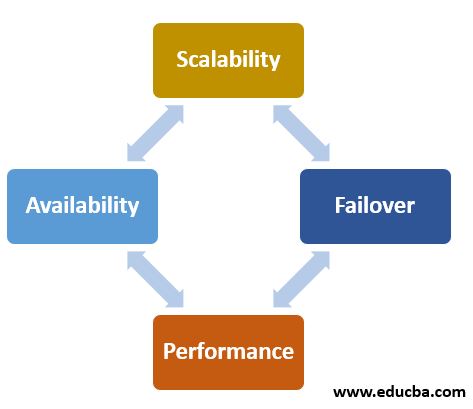Updated May 17, 2023

Introduction to MySQL Cluster
The primary purpose of the database is to store the data required by the user and make it available for use and manipulation whenever required. Even though this statement seems easy to say and fulfill, ensuring that a single database is open to all the users in huge numbers is very tough. Database engineers often face challenges in achieving high availability. To overcome these challenges, multiple techniques are employed. One of the crucial ones is the clustering of the database’s tables. In this article, we will learn about MySQL cluster features, advantages, performance metrics, prerequisites, and when to use the clusters.
Features of MySQL Cluster
MySQL cluster’s current and latest version is 703, and it comes integrated and bundled in Mysql 5.6 version.
Mysql clusters have the following features in it:
- It is real-time functionality that is highly scalable and is entirely compliant as a transactional database that follows all the ACID (Atomicity, Consistency, Isolation, and Durability) properties.
- It is open-source and provides 99.999% availability for the database.
- Mysql clusters are designed to be distributed with a multi-master structure, ensuring no single-point failure possibility exists.
- When scaled horizontally, MySQL clusters excel in serving intensive transactions and read/write operations quickly.
- Mysql clusters are accessible through both types of interfaces, SQL and NoSQL interfaces.
- Mysql cluster can serve millions of operations within a second in real-time implementation with predictable response times that range to some milliseconds.
- Mysql clusters develop the automatic partitioning feature of the database called the sharding technique that balances the load, and data can be stored in memory or disk.
- Linear database scalability allows for easy handling of unpredictable web-based workloads. New nodes to the network of clusters can be added even when the cluster is running, and it has zero downtime, leading to linear scalability.
Prerequisites
There are specific system requirements that your machine should fulfill for using the MySQL clusters that are listed below:
- CPU: Intel/AMD x86 or higher, UltraSPARC or higher.
- Hard disk capacity: Minimum 3 GB.
- RAM capacity: Minimum 1 GB.
- Network: The network should be of gigabit ethernet following TCP/IP protocol and contain more than one node.
When Should We Use MySQL Cluster?
Understanding when we should approach using the MySQL clusters according to our requirements is necessary.
Here are some points to consider when deciding whether to use clusters to manage your database:
- Suppose your database application involves many transactions that have started creating a load on the MySQL server. In that case, you can use the sharding technique of clusters to meet growing numbers of CRUD operations in your database.
- Clusters can be used to ensure consistency is maintained irrespective of which node is serving the select operations for data retrieval.
- If some failure occurs in database service, it will result in the application’s downtime, and whether it is affordable to handle such downtimes.
- If a failure occurs, will there be a data loss that is worth needed to be taken into consideration in those several seconds of the failure?
- To facilitate read and write operations on each node within a specific geographical region, it is essential to provide a replication facility across those regions.
- The number of the operations involved in the transaction should be greater in the count(such as 1000 operations in a single transaction) to run them parallelly on different nodes to increase performance. However, suppose the number of operations is less, such as ten operations in a single transaction. In that case, it will not be preferable to distribute the task on multiple nodes to run the transaction operations parallelly and collect the results, as it will negatively affect the performance.
- They are considering the type of request of data from the applications. Such as whether the retrieval is based upon the primary key of database tables involving few joins on multiple tables or the complete scan of the table records involving joins on other tables that return huge volumes of data in ten thousand rows. In situations where the second case is applicable, clusters can be a preferred solution for improving the performance of applications.
Performance Metrics of MySQL Cluster
Using MySQL clusters in huge databases to manage them is much more profitable. There is a significant increase in the application’s performance if it is data-centric, which is mostly the case in real-time applications.
The following are performance metrics associated with MySQL clusters:
- Scalability: We can scale dynamically, scale out, or scale in. For cost-effectiveness, we generally scale out by using more applications and nodes of data per cluster or increasing the number of CPU threads, or adding more space/ memory to each data node.
- Failover: Whenever there is any database failure, the sub-second failover facility ensures that the service is not interrupted.
- Performance: The response time for data retrieval requests significantly improves, with a maximum response time of 5 seconds. Utilizing one of the NoSQL access methodologies can also enhance response time. MySQL clusters enable performing update operations at a large scale without concerns about database load as the throughput of the database system increases.
- Availability: Mysql cluster usage provides 99.999% of availability, which means less than 5 minutes of downtime/unavailability per year.
Conclusion
Clustering highly increases the performance and makes the retrieval of the query resultset very quick as the execution time lowers because the records are now present in the single location after clustering and are not in the distorted format. This gradually affects the availability of the database for users. As execution time decreases, the access time decreases, making the database available for other users and thus achieving high performance and database availability for users.
Recommended Articles
We hope that this EDUCBA information on “MySQL Cluster” was beneficial to you. You can view EDUCBA’s recommended articles for more information.

